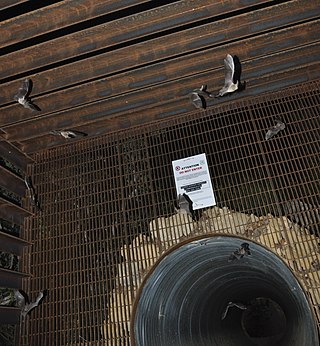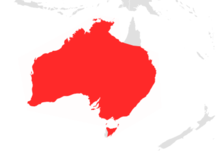
Chalinolobus is a genus of bats, commonly known as pied, wattled, or long-tailed bats. They have fleshy lobes at the bottom edge of their ears and on their lower lips. The bats otherwise classified in the genus Glauconycteris are included in Chalinolobus by some zoologists.

The New Zealand long-tailed bat, also known as the long-tailed wattled bat or pekapeka-tou-roa (Māori), is one of 15 species of bats in the genus Chalinolobus variously known as "pied bats", "wattled bats" or "long-tailed bats". It is one of the two surviving bat species endemic to New Zealand, but is closely related to five other wattled or lobe-lipped bats in Australia and elsewhere. It was named the winner in the 2021 Bird of the Year competition in New Zealand, despite not being a bird.

The soprano pipistrelle is a small species of bat. It is found in Europe and often roosts on buildings.

Gould's long-eared bat is a microbat found in southern regions of Australia. It occurs in eastern Australia, from Queensland to Victoria, and in a smaller isolated range in the south-west of Western Australia.

The fairy martin is a member of the swallow family of passerine birds which breeds in Australia. It is migratory wintering through most of Australia, with some birds reaching New Guinea and Indonesia. It is increasingly a wanderer to New Zealand, where it may have bred. This species is frequently placed in the genus Hirundo as Hirundo ariel. It is monotypic.

The chocolate wattled bat is a bat in the family Vespertilionidae. It is found only in Australia, including the island Tasmania, and widespread in southern regions. It is known to reside from sea level to at least 1,570 metres (5,150 ft) in Victoria.
The New Caledonian wattled bat is a species of vesper bat, family Vespertilionidae. It is found only in New Caledonia.
The little pied bat is a species of vesper bat in the family Vespertilionidae. It is found only in semi-arid woodlands in eastern Australia.

The inland broad-nosed bat is a species of vesper bat. They are endemic to Australia and widespread throughout the inland, especially in arid and semi-arid regions. This insectivorous microbat, measuring 12 centimetres (4.7 in) in length, roosts in tree hollows during the day and forages over woodland and water at night.
The eastern broad-nosed bat or Orion broad-nosed bat is a species of vespertilionid bat. It is found only in Australia, east of the Great Dividing Range, from about Rockhampton to Melbourne, with a small isolated population on the Atherton Tablelands.

Nyctophilus arnhemensis, known as the northern or Arnhem long-eared bat, is a species of Chiroptera (bats) native to northern regions of Australia. The distribution range is from north-western Queensland to northern Western Australia.

Nyctophilus geoffroyi is a vespertilionid bat, a flying nocturnal mammal found in Australia, The species is relatively common. They have been referred to as the lesser long-eared bat.
The large forest bat is a common vesper bat found in southeast Australia, Tasmania, and Lord Howe Island.
The southern forest bat is a vesper bat found in Australia.

The yellow-bellied sheath-tailed bat, also known as the yellow-bellied sheathtail or yellow-bellied pouched bat, is a microbat species of the family Emballonuridae found extensively in Australia and less commonly in parts of Papua New Guinea.

The white-striped free-tailed bat is a species of bat in the family Molossidae. Its echolocation calls are audible to humans, which is a characteristic found in only a few microbat species. The species was formerly classified as Tadarida australis.

A maternity colony refers to a temporary association of reproductive female bats for giving birth to, nursing, and weaning their pups. The colonies are initiated by pregnant bats. After giving birth, the colony consists of the lactating females and their offspring. After weaning, juveniles will leave the maternity colony, and the colony itself will break apart. The size of a maternity colony is highly variable by species, with some species forming colonies consisting of ten or fewer individuals, while the largest maternity colony in the world in Bracken Cave is estimated to have over 15 million bats.

Vespertilionini is a tribe of bats in the family Vespertilionidae. The largest of the tribes in Vespertilioninae, it contains many genera found throughout the Old World and Australasia.
















